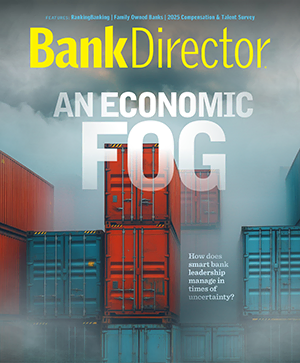
Partnering with the Enemy?

A Federal Reserve survey found that 20 percent of small businesses applying for credit in the first half of 2014 reported they applied through an online lender. “Things are changing so greatly, I don’t understand [bankers] who don’t want to do partnerships,’’ says Mark Pitkin, Sugar River’s president and CEO.
Sugar River is a member of BancAlliance, a membership organization with more than 200 community banks, which recently signed a deal with Lending Club, giving the banks an opportunity to buy loans or portions of loans nationwide, as well as a chance to co-brand a marketing campaign where Lending Club will underwrite and solicit the banks’ own customers for a loan. Prosper Marketplace, another San Francisco-based online lender, signed a similar deal with Western Independent Bankers, giving the association’s roughly 160 members access to the Prosper Marketplace.
Both deals are for unsecured, fixed-rate installment consumer loans, which are billed as less expensive for the consumer than traditional credit card loans, with rates as low as 6.5 percent for the best borrowers. (Lending Club also offers small business loans, but for now, that’s not a part of the BancAlliance deal.)
Community banks in large part have lost market share for consumer loans to bigger banks during the last few decades, as they can’t compete with the efficiencies enjoyed by the bigger banks. Steven Museles, the general counsel and head of client business for Alliance Partners, the Chevy Chase, Maryland-based asset manager that runs BancAlliance, says the average community bank would have to invest tens if not hundreds of thousands of dollars to scale up a consumer lending business. “We think it’s a significant opportunity for our members,’’ he says. “Many of them would have difficulty putting in place a consumer lending program that could get to any scale.”
According to Ron Suber, president of Prosper, banks don’t want to turn their customers away for consumer loans, and they don’t want to push them into high-interest credit card debt. Partnering with Prosper offers a better alternative for the bank, which receives a 4 percent yield. Borrowers also pay about 4 percent as an origination fee to Prosper and the bank pays Prosper 1 percent of the outstanding balance to service the loan, usually with a three-year term. Customers can apply for a loan from their mobile devices or laptops, or while sitting in a bank’s office. The bank can specify the investment grade for the loans it will buy, such as AA loans, and Prosper categorizes them using data on consumers such as a FICO credit score, payment history and debt to income ratios.
But what are the risks? Fitch Ratings’ Brendan Sheehy, director of financial institutions, thinks the online marketplaces could loosen their underwriting standards to generate additional fees for themselves. In 2013, origination fees made up 88 percent of Lending Club’s total net revenues. And he’s not sure how much visibility community banks really will have into the underwriting models the online marketplaces will use. But he also thinks for now, these types of loans will remain a small part of the typical community bank portfolio. Andrew Deringer, the head of financial institutions for Lending Club, says the Lending Club wouldn’t sacrifice its reputation and goodwill by loosening underwriting standards. “The credibility Lending Club has with investors is paramount to the model,’’ he says. “We only build that credibility by building predictable performance to our investors.”
As far as the possibility that Lending Club could steal customers from banks such as Sugar River and offer them other products, the BancAlliance deal includes a provision to protect the bank’s customers from getting other offers from the Lending Club.


